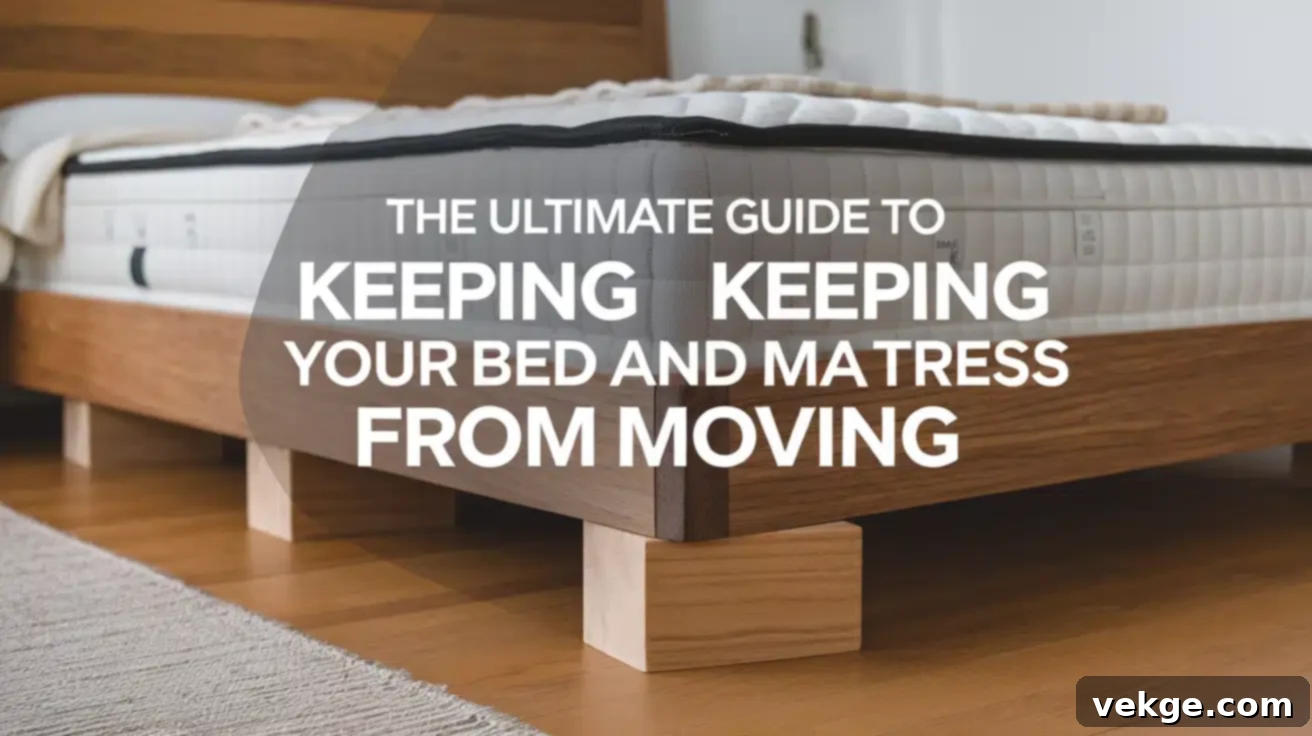Ultimate Guide: How to Stop Your Bed and Mattress from Sliding (Forever!)
Is your morning routine often interrupted by the frustrating sight of your mattress halfway off the bed, or your entire bed frame having mysteriously migrated across your pristine wood floor? You’re definitely not alone in this nightly battle against gravity and friction!
A restless night of tossing and turning shouldn’t culminate in a displaced bed. The annoyance of constantly readjusting your sleeping setup is a common woe, but the good news is that there are numerous effective and surprisingly simple solutions to keep everything firmly anchored exactly where it should be. No more waking up to find your pillow on the floor or your feet dangling off the edge because your bed has moved!
In this comprehensive guide, we will delve deep into the most common culprits behind a wandering bed and a shifting mattress. More importantly, we’ll equip you with a toolkit of practical, long-lasting tips to stop this slipping sensation once and for all. From clever DIY fixes and readily available products designed to secure your mattress to robust solutions for keeping even the heaviest bed frame steadfast on any flooring, we’ve got every angle covered.
Prepare to transform your bedroom into a sanctuary of stability. Let’s explore why these frustrating movements occur and uncover the best strategies to ensure your bed setup remains perfectly in place—granting you the peaceful, uninterrupted sleep you truly deserve, night after night.
Understanding the Root Causes: Why Do Beds and Mattresses Slip?
Before diving into solutions, it’s crucial to understand why your bed or mattress might be making an unwelcome journey across your bedroom. Identifying the specific cause will help you select the most effective remedy. Here are the primary reasons behind bed and mattress slippage:
1. Smooth Flooring Surfaces
One of the most common reasons for a bed frame to slide is the type of flooring it rests upon. Many modern homes feature elegant, smooth surfaces like polished hardwood, sleek laminate, or glossy tiles. While aesthetically pleasing, these floors offer very little friction. When you or your partner move in bed, or even just through routine daily activities, the slight vibrations and shifts can cause the bed frame to slowly but surely slide across these slick surfaces. Lighter bed frames or those lacking protective rubber feet are particularly susceptible to this issue, turning your serene sleep space into a minor ice rink for furniture.
2. Insufficient Grip Between Mattress and Frame
Just as smooth floors pose a challenge for bed frames, a lack of adequate grip between your mattress and the bed frame itself can lead to a sliding mattress. The surfaces of many modern mattresses and bed frames (especially metal or slatted platforms) are often quite smooth. This minimal friction allows the mattress to shift easily with movement, whether you’re getting in or out of bed, or simply adjusting your sleeping position. Over time, this constant shifting can even cause your sheets to become dislodged or your pillows to fall.
3. Mattress Weight and Material
The weight and material composition of your mattress play a significant role in its stability. Generally, lighter mattresses, such as many types of memory foam or hybrid mattresses, tend to slide more easily than heavier traditional innerspring mattresses. A lighter mattress offers less resistance to movement and has less gravitational force pinning it to the bed frame. Furthermore, the outer fabric of some foam mattresses can be particularly slick, reducing the natural friction that would otherwise keep it in place.
4. Wear and Tear Over Time
Like all furniture, bed components can degrade and wear down over time. A bed frame might become loose at its joints, developing a slight wobble that facilitates movement. Similarly, the mattress itself can lose its original shape or develop slick spots as its outer fabric wears smooth. This reduction in structural integrity and surface friction makes your entire bed setup less stable and more prone to unwelcome shifting. Old mattresses, in particular, often lose the inherent grip they once had with the bed frame.
5. Uneven or Sloping Floors
An often-overlooked culprit for a sliding bed is an uneven floor. In older homes, apartments, or even some new constructions, floors might not be perfectly level. If your bed is situated on a subtle slope, gravity will relentlessly pull it towards the lower side. This movement might be imperceptible at first, occurring slowly over days or weeks, but it inevitably leads to a noticeable shift in your bed’s position, requiring constant manual adjustments.
6. Mismatched Bed Frame and Mattress Size
A common mistake that leads to mattress slippage is using a bed frame that is too large for your mattress. When there’s extra space between the mattress and the frame, it creates an allowance for movement. This “play” means your mattress isn’t snugly held in place, enabling it to slide back and forth or side to side with minimal effort. Ensuring a perfect fit is critical for stability, as a mattress that’s even slightly too small will invariably become a restless wanderer.
7. Dynamic Movement During Sleep
For individuals or couples who are particularly active sleepers, frequent tossing, turning, and shifting during the night can be a major factor in a sliding bed. This is especially true if you have a lightweight bed frame, a particularly slick mattress, or if the mattress isn’t otherwise securely anchored to the frame. The combined momentum of sleep movements can exert enough force to dislodge both the mattress and the entire bed frame, disrupting your sleep and your bedroom’s organization.
By understanding these common causes, you are now better equipped to diagnose the specific problem affecting your sleep setup. In the following sections, we’ll provide targeted, effective strategies to counteract each of these issues and restore ultimate stability to your bed.
How to Keep Your Bed Frame from Sliding on Any Floor
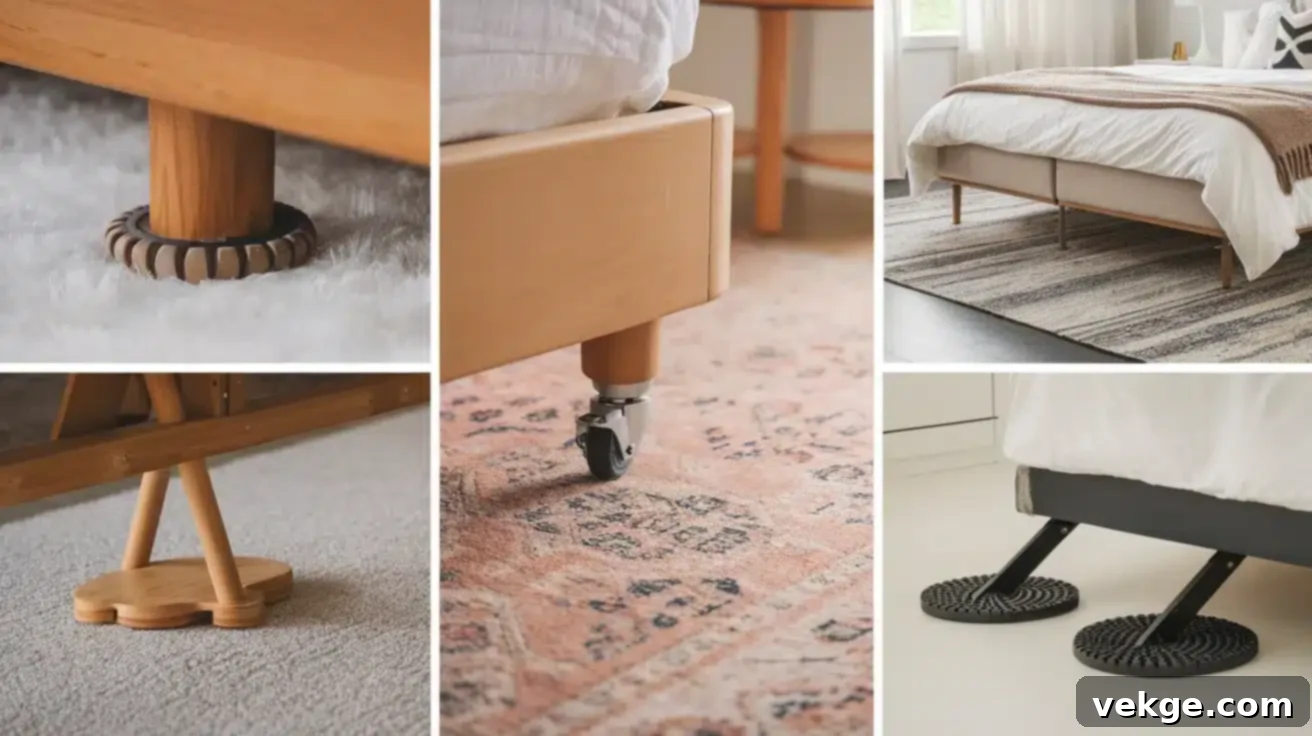
Whether you have sleek hardwood, modern laminate, or polished tile floors, preventing your bed frame from sliding is essential for a stable sleeping environment. Here are effective strategies to keep your bed frame securely anchored:
1. Utilize High-Grip Rubber Stoppers or Furniture Cups
Rubber stoppers or furniture cups are perhaps the simplest and most effective solution for preventing bed frame movement, especially on smooth surfaces like wood or tile. These small, yet powerful, pads or cups are designed to be placed directly under each bed leg. Their high-friction rubber material creates a strong grip against the floor, significantly reducing the likelihood of slippage without causing any damage. They are incredibly easy to install, often requiring no adhesive, and can be removed just as simply if you need to reposition your bed.
2. Employ Non-Slip Furniture Pads or Grippers
Beyond basic rubber stoppers, specialized non-slip furniture pads offer an excellent alternative. These typically feature a soft, adhesive side that attaches firmly to the bottom of your bed legs and a highly textured, grippy side that firmly anchors to the floor. Available in various shapes and sizes—from round to square—they can accommodate almost any bed frame leg. They provide superior friction and are often durable enough to withstand years of use, preventing both sliding and potential floor scratches.
3. Strategically Place a Large Area Rug Under Your Bed
A well-chosen area rug can be both a decorative asset and a practical solution for a sliding bed frame. Placing a large rug that extends beyond the bed frame on all sides dramatically increases friction between your bed and the floor. For maximum effectiveness, ensure the rug itself has a non-slip backing (or place a separate non-slip rug pad underneath it). This method not only stabilizes your bed but also adds warmth, texture, and a touch of personal style to your bedroom decor, tying the whole room together.
4. Invest in Furniture Gripper Pads with Adhesive Backing
For a more permanent and robust solution, consider furniture gripper pads that come with strong adhesive backing. These are typically made from durable rubber or felt-rubber composites and adhere directly to the bottom of your bed legs. Once attached, they create a formidable barrier against sliding. While highly effective, be mindful that removing them might require some care to avoid leaving residue or potentially damaging delicate finishes on your bed frame legs.
5. Use Double-Sided Carpet Tape for Temporary Hold
If you’re looking for a quick, temporary fix, double-sided carpet tape can be surprisingly effective. Apply strips of this strong tape to the bottom of your bed legs and then press them firmly onto the floor. The tape creates a strong, albeit temporary, bond that can prevent minor slippage. However, use this method with caution, especially on delicate wood or laminate floors, as removing the tape can sometimes leave sticky residue or even pull up finishes if not done carefully.
6. Maintain Clean Floors for Optimal Friction
This simple tip is often overlooked but can make a difference. Dust, dirt, and debris can accumulate on your floor, acting like tiny ball bearings that reduce friction between your bed legs and the floor. Regularly sweeping, vacuuming, and mopping the area under and around your bed frame ensures that the surfaces are clean, allowing any non-slip pads or the bed legs themselves to maintain optimal grip. A clean floor contributes significantly to overall bed stability.
7. Add Weight to the Bed Frame
A heavier bed frame is inherently more resistant to movement. If your current frame is particularly lightweight, consider adding some weight to its structure. This can be achieved by storing heavy items—like books, storage boxes filled with less frequently used items, or even workout weights—underneath your bed, especially if your frame has under-bed storage capabilities. The added mass increases the inertia of the bed, making it much harder to accidentally shift.
8. Ensure the Bed Frame is Level and Tightened
A wobbly or unlevel bed frame is an invitation for sliding. Use a spirit level to check if all the legs of your bed frame are evenly touching the floor and if the frame itself is level. If not, minor adjustments to the leg height (if adjustable) or the strategic placement of thin shims (small wedges made of wood or rubber) under shorter legs can rectify the issue. Additionally, periodically check and tighten all bolts and screws on your bed frame. Loose connections can introduce instability and contribute to unwanted movement.
By implementing one or a combination of these methods, you can effectively stabilize your bed frame, ensuring it remains steadfast on any type of flooring, and contributing to a more restful night’s sleep.
Effective Strategies: How to Stop Your Mattress from Sliding
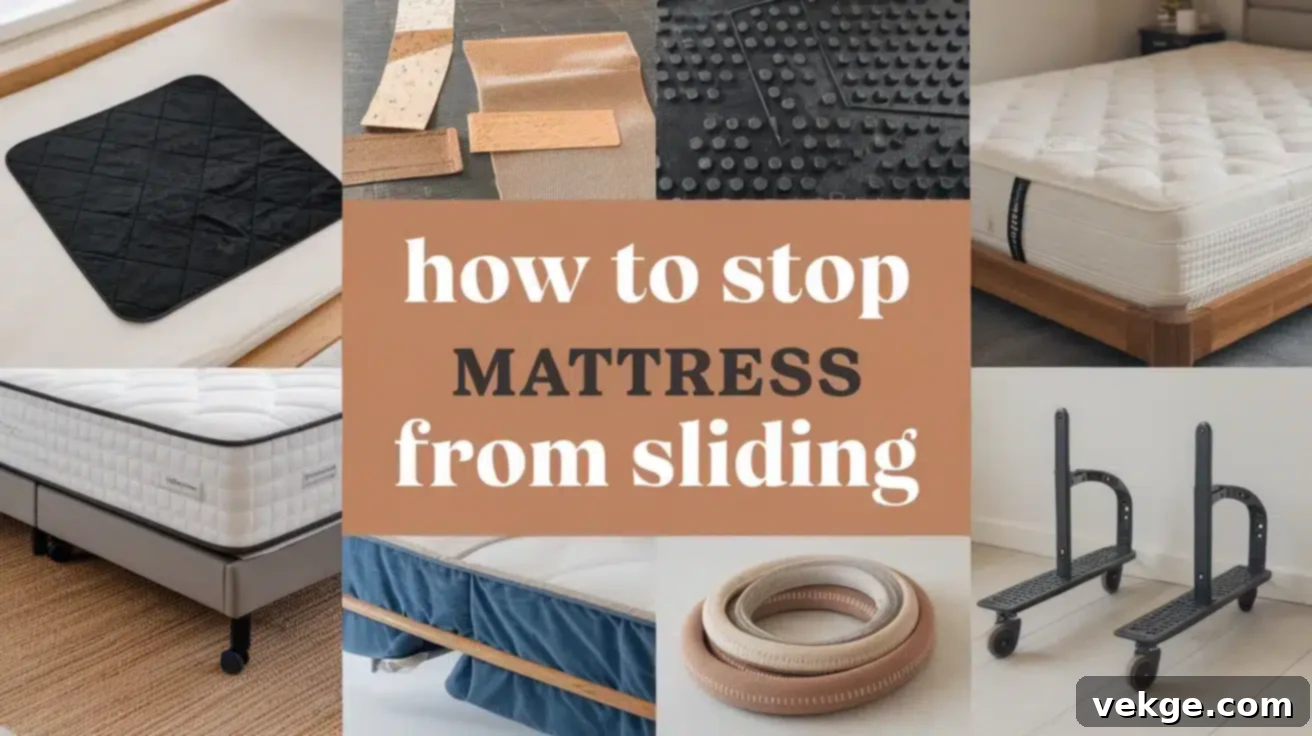
A sliding mattress is a common nuisance that disrupts sleep and requires constant readjustment. Fortunately, there are several straightforward and highly effective solutions to keep your mattress securely in place on your bed frame or box spring:
1. Utilize a High-Quality Non-Slip Mattress Pad or Gripper
This is arguably the most popular and effective solution for a sliding mattress. A dedicated non-slip mattress pad, often made from rubberized mesh or a similar high-friction material, is placed directly between your mattress and the bed frame (or box spring/slats). These pads work by creating a textured, grippy surface that dramatically increases the friction, preventing the mattress from shifting with your movements. They are available in all standard mattress sizes and can often be trimmed for a perfect fit, offering an invisible yet powerful barrier against slippage.
2. Apply Heavy-Duty Velcro Strips
For a more robust and semi-permanent fix, heavy-duty Velcro strips are an excellent choice. Simply attach one side of the Velcro (the hook side) to the underside of your mattress using its strong adhesive backing, and the corresponding loop side to the top surface of your bed frame or slats. For best results, use several wide strips strategically placed around the perimeter of the mattress. This creates a secure, yet detachable, bond that allows you to lift the mattress for cleaning while ensuring it stays put during normal use. Ensure the adhesive is suitable for both your mattress fabric and bed frame material.
3. Place a Rubber Mat or Shelf Liner Underneath
Similar in principle to a non-slip mattress pad, a thin, textured rubber mat or even heavy-duty rubber shelf liner can be repurposed to prevent mattress sliding. Simply cut the rubber mat to the size of your mattress or slightly smaller and lay it flat on the bed frame before placing your mattress on top. The inherent grip of the rubber material significantly increases friction, making it much harder for the mattress to move around. This is a cost-effective and easily implementable solution for most bed types.
4. Ensure Sheets and Bedding are Tightly Fitted
While seemingly simple, the way you make your bed can actually contribute to mattress stability. Using deep-pocketed fitted sheets that snugly wrap around the mattress, and ensuring they are tucked in tightly, can provide a surprising amount of hold. The tension from well-fitted sheets acts as an additional layer of restraint, helping to keep the mattress from shifting, especially on softer or lighter mattresses. Regularly adjust and re-tuck your bedding for continuous effectiveness.
5. Verify Your Mattress and Bed Frame Size Match Perfectly
One of the most fundamental steps in preventing mattress slippage is ensuring that your mattress and bed frame are a perfect match in size. A mattress that is even slightly too small for its frame will have ample room to slide and shift. Before investing in other solutions, double-check the dimensions of both your mattress and bed frame. If there’s a significant mismatch, upgrading to a properly sized frame or mattress might be the ultimate solution to eliminate unwanted movement.
6. Use Bed Skirt Pins or Suspenders
For an extra layer of security, especially with a box spring and mattress combination, bed skirt pins (also known as upholstery twist pins) can be used. These small, spiral pins can be twisted into the sides of the mattress and box spring to connect them, preventing horizontal movement. Alternatively, mattress suspenders or straps that wrap around the mattress and secure underneath the frame can provide a tight, unyielding hold, particularly useful for bunk beds or very active sleepers.
By implementing these proven methods, you can put an end to the frustrating problem of a sliding mattress and enjoy a more stable, comfortable, and undisturbed sleep environment.
Recommended Anti-Slip Products for Enhanced Bed Stability
Disclaimer: These recommendations are based on widely available products known for their effectiveness. None of the links provided are affiliated or sponsored. Always check product reviews and compatibility with your specific bed type.
1. Non-Slip Mattress Pads/Grippers

- Gorilla Grip Original Mattress Gripper Pad: Renowned for its superior grip, this non-adhesive, slip-resistant pad is designed to keep mattresses firmly in place on various surfaces, including platform beds and box springs. It’s available in multiple sizes and can be easily trimmed to achieve a custom fit, making it a versatile and highly effective choice.
- Home Techpro Non-Slip Mattress Grip Pad: This budget-friendly option consistently receives high marks for providing a solid and reliable grip. It’s particularly effective at preventing mattress movement on slick surfaces like wood and tile bed frames, offering a cost-effective solution without compromising on stability.
2. Furniture Grippers for Bed Frames
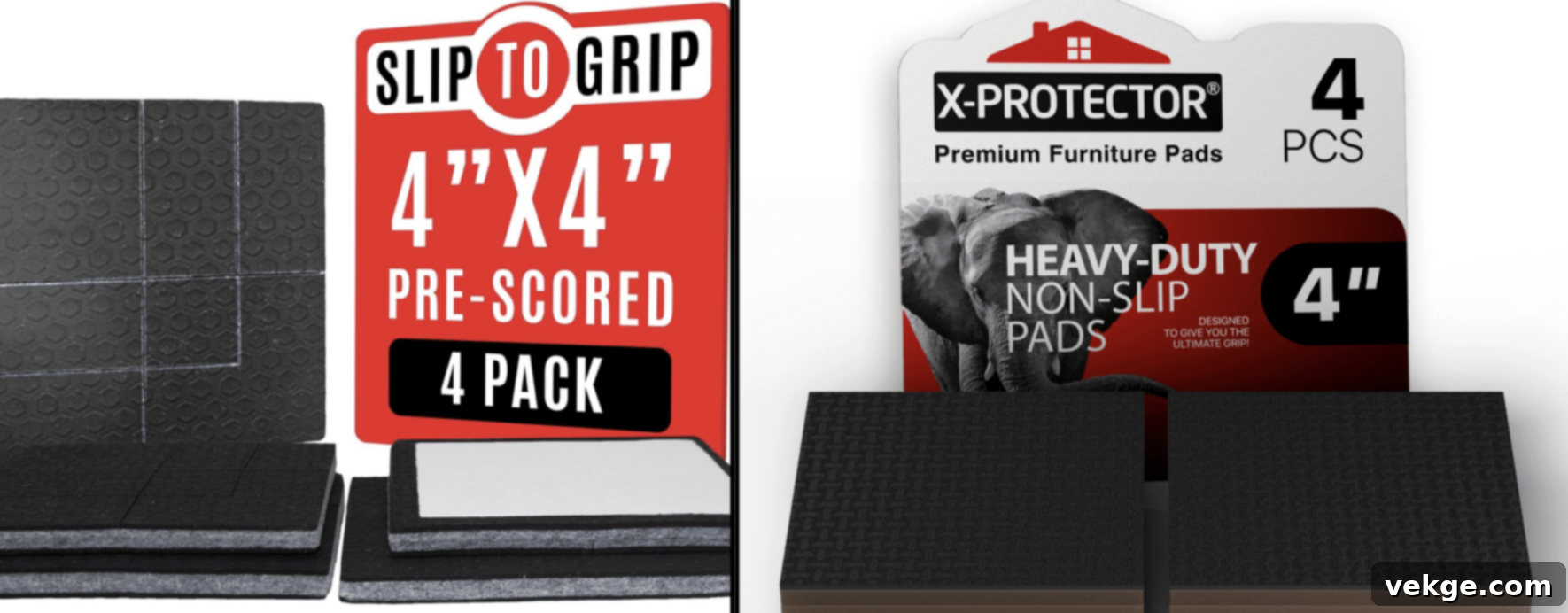
- SlipToGrip Furniture Gripper Pads: These robust rubber grippers are designed for heavy furniture. Coming in convenient multi-packs, they provide an exceptional stronghold for bed frames on a variety of flooring, including wood, tile, and even carpet. Their durable construction ensures long-lasting stability.
- X-Protector Non-Slip Furniture Pads: Known for their high quality and innovative design, these rubber pads are engineered to keep even the heaviest furniture, such as large bed frames, from sliding. They are available in various shapes and sizes to perfectly fit different bed legs, providing reliable floor protection and superior grip.
3. Rubber Leg Covers/Cups for Metal Frames

- Slipstick CB652 3-inch Rubber Floor Protectors: These durable rubber cups are specifically designed to fit over metal bed frame legs, providing a snug fit and creating strong friction. They are highly effective at preventing sliding on wood or tile floors while also offering robust protection against scratches and dents.
- Wobble Wedge Rubber Shims: While often used for leveling, these versatile rubber wedges can also be strategically placed under metal frame legs to stabilize and prevent slipping on uneven floors. Their grippy texture helps anchor the leg, preventing movement and eliminating annoying wobbles.
4. Heavy-Duty Velcro Strips for Mattresses
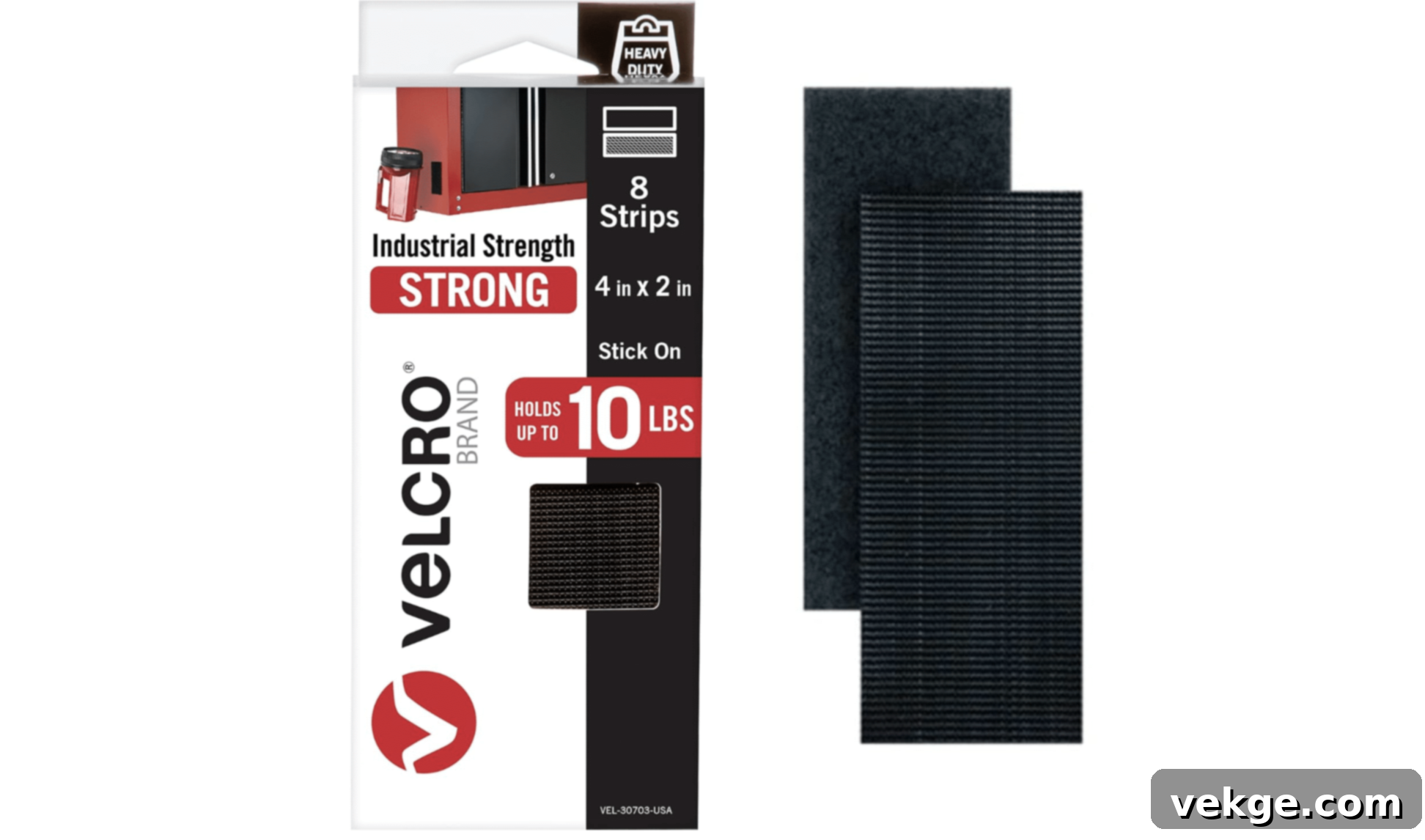
- VELCRO Brand Heavy Duty Strips: These industrial-strength adhesive strips are ideal for securely attaching your mattress to your bed frame or box spring. The strong adhesive ensures a lasting bond, while the hook-and-loop system allows for easy separation when needed for cleaning or repositioning, making them a highly effective and flexible solution for persistent mattress sliding.
Advanced Strategies and Additional Tips for Enhanced Bed Stability
Beyond the fundamental fixes, incorporating these additional strategies can further bolster the stability of your bed setup, ensuring a truly immovable and comfortable sleep experience:
1. Secure and Tighten Your Headboard
Often overlooked, a loose or wobbly headboard can be a significant contributor to overall bed movement. The constant slight shifts and vibrations transmitted through a poorly secured headboard can cause the entire bed frame to inch across the floor. Regularly check the bolts and screws that connect your headboard to the bed frame. Tighten them firmly, and consider using washers or locknuts if they tend to loosen frequently. A firmly anchored headboard dramatically reduces incidental movement and improves the structural integrity of your entire bed.
2. Integrate a Bunkie Board for Platform Beds
For platform beds or bed frames with widely spaced slats, a bunkie board can be a game-changer. A bunkie board is a thin, solid, or slatted foundation that sits directly on top of your bed frame slats, underneath your mattress. It provides a continuous, firm surface that not only supports your mattress better (preventing sagging) but also creates a more stable, non-slip base for the mattress itself. This added layer of rigid support significantly reduces mattress movement, especially with lighter foam mattresses.
3. Regularly Inspect and Tighten Bed Frame Screws and Bolts
The structural integrity of your bed frame is paramount to its stability. Over time, due to daily use, movement, and the natural vibrations of a home, the screws, bolts, and other fasteners in your bed frame can gradually loosen. This can lead to creaking, wobbling, and ultimately, an increased tendency for the bed to slide. Make it a routine to inspect and tighten all connections in your bed frame every few months. This simple maintenance step can prevent a host of stability issues and prolong the life of your furniture.
4. Add a Mattress Topper for Increased Friction and Weight
While primarily chosen for comfort, a well-fitting mattress topper can also play a role in reducing mattress slippage. A thicker, heavier topper adds additional weight to your mattress, increasing the downward pressure and thus friction against the bed frame. Furthermore, many toppers have a slightly textured underside or are designed with a non-slip backing, which further enhances the grip between the mattress and the frame, making it less prone to accidental movement.
5. Consider a Platform Bed with a Solid Base
If you’re in the market for a new bed, consider the inherent stability of a platform bed. Many platform beds are designed with a solid base that makes direct contact with the floor over a larger surface area, or they have more robust, wider legs. This design provides superior inherent stability compared to traditional bed frames with thin legs and a box spring. A platform bed often eliminates the need for a separate box spring, simplifying your setup and reducing points of potential slippage.
6. Employ Bed Slat Grips for Enhanced Support
For bed frames that utilize wooden or metal slats, the slats themselves can sometimes shift, contributing to overall mattress movement. Bed slat grips are small, rubberized strips that can be adhered to the top of your bed slats. These strips create additional friction, preventing both the slats from moving within the frame and the mattress from sliding on top of the slats. This targeted solution ensures that every component of your bed frame contributes to a unified, stable sleeping surface.
By thoughtfully applying these advanced tips, you can significantly enhance the long-term stability and security of your bed, ensuring a tranquil and uninterrupted sleep experience for years to come.
Conclusion: Reclaim Your Stable Sleep
Let’s bring our ultimate guide on achieving a stable bed and mattress to a close. We’ve journeyed through the common frustrations of a wandering bed and a shifting mattress, exploring the myriad reasons behind their unwelcome movements—from slick flooring and lightweight designs to wear and tear and active sleep styles.
The good news, as we’ve thoroughly demonstrated, is that there’s a practical and effective solution for every scenario. Whether your challenge lies with a bed frame stubbornly sliding across a polished hardwood floor or a mattress that refuses to stay put on its foundation, the remedies are within reach. From simple, yet powerful, rubber stoppers and innovative non-slip pads to strategic furniture placement and diligent maintenance, you now possess a comprehensive toolkit to tackle any stability issue.
Remember, a truly stable bed is not merely a matter of convenience; it’s a cornerstone of quality sleep. The peace of mind that comes from knowing your bed is securely anchored allows your body and mind to fully relax and recuperate. Regular checks, proactive upkeep, and the intelligent application of these anti-slip strategies can prevent future disruptions and transform your bedroom into the unwavering sanctuary it’s meant to be.
No matter if your bed frame is metal, wood, or a platform style, and regardless of your mattress type, there is a tailored fix waiting for you. By adopting the insights and recommendations from this guide, you can definitively say goodbye to the vexation of sliding beds and the restlessness of interrupted nights.
Your bed should be a steadfast haven of comfort, not a constant source of frustration and realignment. With just a little effort and the right solutions, you can effortlessly create a steady, unmoving sleep space that stays perfectly put, night after glorious night.
Sweet dreams await on your newly stabilized, perfectly positioned bed!
